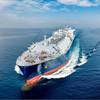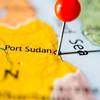Public seaports across the United States are weighing in this week on the Administration's requested Fiscal Year 2006 federal budget. Ports are deeply concerned about recommended elimination of the Department of Homeland Security's Port Security Grant Program by lumping it into a sweeping new program that combines the security infrastructure needs of seaports with those of trains, trucks, busses and other public transit. In addition, ports are concerned about the Administration's proposed budget, which would significantly under-fund the U.S. Army Corps of Engineers' Civil Works program and needed deep-draft dredging projects.
"Protecting America's marine facilities from acts of terrorism must be a top Administration priority and a shared responsibility between the ports, government and private industry," said Kurt Nagle, president and CEO of the American Association of Port Authorities (AAPA). "Another top Administration priority must be to adequately fund the U.S. Army Corps of Engineers to keep the nation's deep-draft navigation maintenance projects on schedule, ensure existing construction isn't delayed, and allow some of the dozens of already-approved new construction projects to finally get started."
Nagle noted that our economy, our safety and even our national defense depends largely on how well we can protect our seaports and ensure deep-draft shipping access to them. "Unfortunately, the proposed federal budget the Administration released yesterday literally removes port security as a separate line item and leaves gaping holes in funding for the dredging needs of U.S. ports." In the proposed FY'06 federal budget, the Administration would eliminate the Port Security Grant Program, which Congress created after 9/11 to reimburse U.S. maritime facilities for pre-approved projects required by federal regulations to enhance national security. In its place would be the newly-created Targeted Infrastructure Protection program that would lump grant proposals from ports together with requests from a host of other transportation-related industries. "What the Administration's recommendation would do is to take a grant program that helps fund projects that defend our borders and has clearly-defined costs, and roll it into a nebulas new program that pits border security needs against domestic security programs," said Nagle. "Port security needs have been identified as so critical that they've justified federal legislation, specific regulatory requirements, and up until now, a dedicated grant program that addresses those needs."
Since 2002, the DHS's Port Security Grant Program has provided much-needed support to address immediate security needs and assessments. But federal money allocated in the first four rounds of the program- about $565 million- accounted for only about one-sixth of what seaports identified as needs, while a fifth round of grants totaling $150 million has yet to be made available to ports. At the same time, the U.S. Coast Guard has estimated that ports would have to spend $5.4 billion over ten years on mandated security enhancements. That's on top of the more than $3 billion they already spend annually on infrastructure improvements and operations, maintenance and personnel expenses just to keep pace with burgeoning world trade.
While airports receive most of the federal attention and funding for security and terrorism prevention, seaports - which support 4 million jobs and annually handle $2 trillion worth of cargo and more than 7 million cruise ship passengers - remain largely under-funded at the federal level. As a result, they often must sacrifice important transportation and economic development initiatives by diverting scarce state and local funds to pay for enhanced security.
"We're encouraged by the intent of the Dec. 21, 2004, Presidential Directive on marine security, which is to integrate and coordinate maritime related security efforts, such as the Container Security Initiative and Operation Safe Commerce," said Nagle. "We're also encouraged that the budget proposed increases funding for certain federal programs to enhance maritime security, such as U.S. Coast Guard programs, the Container Security Initiative, radiological detectors and the Customs Trade Partnership Against Terrorism program. However, we're disappointed that neither the directive nor the proposed budget addresses the need for adequate federal funding assistance to enable state, county and city-run public ports to implement timely facility security enhancements without their having to delay or forego other important projects critically needed to handle ever-increasing volumes of international commerce."
In addition to changes to the Port Security Grant Program, the Administration's budget request would cut funding for the Corps of Engineers' Civil Works program, which includes money for construction, maintenance and study of deep-draft dredging projects in America's harbors and navigation channels. The Administration's Civil Works budget recommendation this year is $4.513 billion, which is 4 percent less than FY'05 appropriated levels.
For FY'06, AAPA urges appropriations of $735 million for deep-draft navigation operations and maintenance (O&M), at least $500 million for deep-draft construction, and $10 million for new project studies. That compares with the Administration's request of $607 million for harbor and channel O&M, $260 million for continuing construction and $7 million for studies. Although the FY'06 revenue into Harbor Maintenance Trust Fund, which funds O&M projects, is projected to exceed $1 billion, far less would be spent and the current $2.6 billion fund surplus would continue to increase.
According to AAPA's president, under-funding the Corps of Engineers' Civil Works program will create major challenges for public ports, ocean carriers and their customers to meet the expectations of the businesses and communities they serve, both from a safety and an economic perspective. He says that each year that new dredging projects are delayed and existing projects go unfinished, it puts our nation at a competitive disadvantage to export its products overseas and causes the cost of waterborne imports to go up.
Thomas Donohue, president and CEO of the U.S. Chamber of Commerce and president of the National Chamber Foundation, points to the fact the U.S. is the world's largest importer and exporter, accounting for nearly 20 percent of the annual world ocean-borne trade. "The nation's transportation system is the lifeblood of our economy," he said. "Without additional investment in our infrastructure, our system of commerce is impaired, our mobility is restricted, our safety is threatened, our environment is endangered, and our way of life is compromised." Within the next 15 years, industry analysts predict the approximately 2 billion tons of cargo that U.S. ports and waterways now handle each year will double. At that rate, the volume of trade moving through America's port facilities will grow to as much as one-third of the Gross Domestic Product. In response, seaports across the country are expanding to meet the increased demand for their services, necessitating huge expenditures in infrastructure, equipment and personnel.












